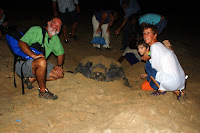Leatherbacks are the largest turtles on Earth, growing up to seven feet long and exceeding 2,000 pounds. These reptilian relics are the only remaining representatives of a family of turtles that traces its evolutionary roots back more than 100 million years. Once prevalent in every ocean except the Arctic and Antarctic, the leatherback population is rapidly declining in many parts of the world.
While all other sea turtles have hard, bony shells, the inky-blue carapace of the leatherback is somewhat flexible and almost rubbery to the touch. Ridges along the carapace help give it a more hydrodynamic structure. Leatherbacks can dive to depths of 4,200 feet (1,280 meters)—deeper than any other turtle—and can stay down for up to 85 minutes.
Leatherbacks have the widest global distribution of all reptile species, and possibly of any vertebrate. They can be found in the tropic and temperate waters of the Atlantic, Pacific, and Indian Oceans, as well as the Mediterranean Sea. Adult leatherbacks also traverse as far north as Canada and Norway and as far south as New Zealand and South America. Unlike their reptilian relatives, leatherbacks are able to maintain warm body temperatures in cold water by using a unique set of adaptations that allows them to both generate and retain body heat. These adaptations include large body size, changes in swimming activity and blood flow, and a thick layer of fat.
Leatherbacks undertake the longest migrations between breeding and feeding areas of any sea turtle, averaging 3,700 miles each way. After mating at sea, females come ashore during the breeding season to nest. The nighttime ritual involves excavating a hole in the sand, depositing around 80 eggs, filling the nest, leaving a large, disturbed area of sand that makes detection by predators difficult, and finally returning to the sea. This was the event that we wanted to witness.
The temperature inside the nest determines the sex of the hatchlings. A mix of male and female hatchlings occurs when the nest temperature is approximately 85.1 degrees Fahrenheit (29.5 degrees Celsius), while higher temperatures produce females and cooler temperatures produce males. Female hatchlings that make it to sea will roam the oceans until they reach sexual maturity, when they return to the same nesting areas to produce their own offspring. Males spend the rest of their lives at sea.
It was in search of these giants that the crew of Emily Grace climbed into a bus at 5 PM for a 3 hour ride to the Northeast coast of Trinidad. We stopped along the way and had dinner at a roadside diner. From about May through August, thousands of giant leatherbacks return to the beachs of Trinidad to lay their eggs -- At the peak of laying season, between 300 to 500 come ashore each night, each of them laying between 80 to 100 eggs in each nest.
We arrived after dark and were met by a group of guides and were to wait off the beach until we received word that a turtle was sighted. It is illegal to go on the beach at night without the company of a certified guide (which was included in our excursion). Guides take groups of people out onto the beach with the help of a red light (regular flashlights disorient the turtles), and each guide is trained and knowledgeable about anything you'd ever want to learn about the turtles -- the fact that it is believed that the turtles return to the beach on which they were hatched; that they generally love the waters of the arctic and northern oceans, and actually travel thousands of miles to the Caribbean and South America to lay their eggs, so that the warm sands provide the proper temperature for incubation; and that while they seem clumsy on land, they are incredibly fast in the ocean, able to outswim sharks, and dive deeper than whales.
Because flashbulbs are prohibited at night, it can be very difficult to photograph the turtles after sundown. It was discovered, however, that the period when actually laying eggs the turtles are unaffected by lights as they enter a kind of trance. We were allowed to take a few photos for about 10 minutes of the entire night. Since it was too dark to take video, I borrowed a video from the internet that shows what we saw and included it below.
We were lucky to see 3 or 4 turtles laying eggs and one nest of hatchlings scurrying across the beach towards the water. Our guide almost stepped on one baby since he was rushing over to see another adult.
As we rode back on the bus we all reflected on how fortunate we were to witness this unique event. It was almost 2 AM when we finally climbed back aboard and snuggled in our beds to rest up for our next adventure.
Tom
Saturday, July 25, 2009
Subscribe to:
Comments (Atom)








